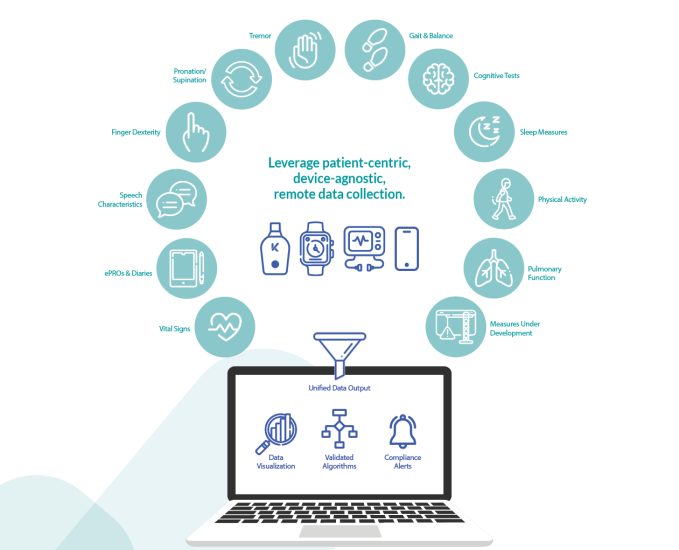Rating symptoms on a numerical scale seems easy, but it can be harder than it appears. How much did it hurt when you stubbed your toe? Was it a two out of 10? A four? How often do you wake up at night? Twice, three times? Regularly? Rarely?
These imprecise, self-reported scales can be found throughout medicine, even relating to diseases where the stakes are higher than a bruised toenail. Koneksa, founded in 2013, is working toward discovering and validating clinical biomarkers. That process begins by looking to turn those analog scales digital — and improve them in the process.
Koneksa has developed a software suite that works with a variety of devices, from portable spirometers to iPhones and Apple Watches. These devices capture data, from which software gleans clinically useful signals and organizes them for review by drug companies or healthcare providers running clinical trials.
On the back of several studies, and work with clinical trials at over 700 sites, Koneksa is announcing a Series C raise of $45 million. The company has been comparatively frugal so far, raising $4 million in Series A and seed funding, and a $16 million Series B.
This round will be part of a big push to usher in what CMO John Wagner calls an “inflection point” in the digital biomarker world. (Wagner comes to Koneksa after stints at Cynga, Merck, Takeda and Foresite Capital. He also edited the journal Clinical and Translational Science.)
“It’s well known that the more measurements you take, the more accuracy you get, and the more power a clinical trial can have. That makes [the trial] smaller, faster and more efficient,” Wagner told TC. “I like to think of it as the difference between a still photo and a video. A still photo is great, but a video is able to tell the whole story. That’s how we think of digital biomarkers: they tell the whole story compared to traditional biomarkers.”

Koneksa’s tremor assessment tool for Parkinson’s. Image Credits: Koneksa
How does Koneksa go about turning analog scales into digital ones? Parkinson’s offers a clear example. A common, but imperfect, index used to evaluate Parkinson’s patients is called the Unified Parkinson’s Disease Rating Scale — it’s a multi-part exam that combines questionnaires about mood, daily life and symptoms, with clinical evaluation, like movement tests.
To quantify a tremor, a physician might ask a patient to stretch out an arm, and flip their palm upwards and downwards as fast as they can. Meanwhile, the clinician watches for subtle changes in speed or shape of that movement. Koneksa’s approach, instead, has that patient hold their phone, and perform the same motion. The phone’s accelerometer and gyroscope record those changes and transmit data to the company’s platform.
Behind the scenes, the company’s algorithms “score” that tremor, similar to how a physician might assign a score after an exam.
“The potential of these sensors to give is a far more granular and, I use this word carefully, a more objective, reading of a man’s tremor — there’s tremendous potential in what our technology can do,” CEO Chris Benko told TC.
The idea of revamping analog patient monitoring techniques with tech has already attracted lots of companies. Koneksa is certainly playing in that world, but it doesn’t have its sights set on just software. It’s going after proving the whole thesis of digital biomarker reliability — if not supremacy.
It’s great if a phone can pick up tiny hand movements that a doctor might miss. But do those hand movements actually represent tremors? And, do these digitized tests actually tell doctors anything about how patients will fare later on?
To know the answers to those questions, digital biomarkers need to be clinically validated. Without that validation, such tools are ultimately useless in clinical trials.
“We wanted to focus on gatekeeping problems that are important for getting new therapies to market for patients, and then figure out how to do the scientific validation that shows these technology tools are better or equivalent to what’s out there. We have to do that to the standard of the world’s leading drug companies,” Benko said.
That validation is Koneksa’s current focus. In that regard, the company has been able to show that at-home measures do correlate with tests done in a clinic.
One study on 12 asthma patients, for example, showed that readouts from an at-home spirometer were comparable to those done in a clinic. The patients did make some mistakes, noted Benko, but because they were able to perform the test more often, the investigators ended up with far more data to work with.
A typical asthma clinical trial, the study notes, would need to enroll about 100 patients to get a meaningful result. Using the at-home tests, the authors suggest they could get the same results with just 18 people. “That’s what’s economically interesting to the drug company,” said Benko. “But for the patients, they’re simply saying, it’s more convenient, and it’s more real world.”
The company has also been able to make a compelling case that in-home patient data may yield clinically meaningful insight. For instance, the company has run one study on 66 patients with head and neck cancer, where they used wearable devices to measure daily step counts.
For every 1,000 steps walked, the study found a 26% reduction in hospitalization risk faced by the patients. However, as Benko noted, it was their activity on the weekends (i.e. movement that patients chose themselves) that revealed this statistic, not the movement schedules they adhered to because of weekday responsibilities.
That study was presented at the 2021 American Society of Clinical Oncology meeting, but was not published in a journal.
Still, the ultimate decider of clinical validity, at least when it comes to developing drugs, is the FDA. The next step for Koneksa will be to prove these biomarkers are reliable enough to integrate them into the regulatory decision making process.
“What we’re teeing up right now are Koneksa-owned or Koneksa-collaboration studies with academics in order to push the envelope on clinical validation,” said Wagner.

Koneksa’s complete range of measures. Image Credits: Koneksa
As for the Series C milestones, Koneksa has two goals.
The first is to add to the evidence that backs up their digital biomarker pipeline. In the past, the company has worked alongside their pharma partners to seek out digital biomarkers and validate them. Getting the validation done ahead of these partnerships will allow Koneksa to get new programs off the ground far faster.
The second piece is a launch of what Benko calls a “self-service” platform. This self-service platform allows new partners to combine data from multiple devices and wearables into the same place, and organize them into a dashboard.
“We recognize that the software’s ability to integrate that [disparate] device data in a clinical trial setting is unique. There isn’t another asset like it on the market. And so why should we control it for every possible use? We want to be able to open it up to say: ‘hey, we can license this platform to you.’”
Though these two goals are operationally distinct, they do have a similar flavor. Koneksa is looking to turn their digital biomarkers and platform into a turnkey solution.
This round was led by AyurMaya, a fund managed by Matrix Capital Management, with participation from Takeda Ventures and Velosity Capital. Existing investors McKesson Ventures, Merck Global Health Innovation Fund, Novartis (dRx Capital), Spring Mountain Capital and Waterline Ventures also participated in the round.









